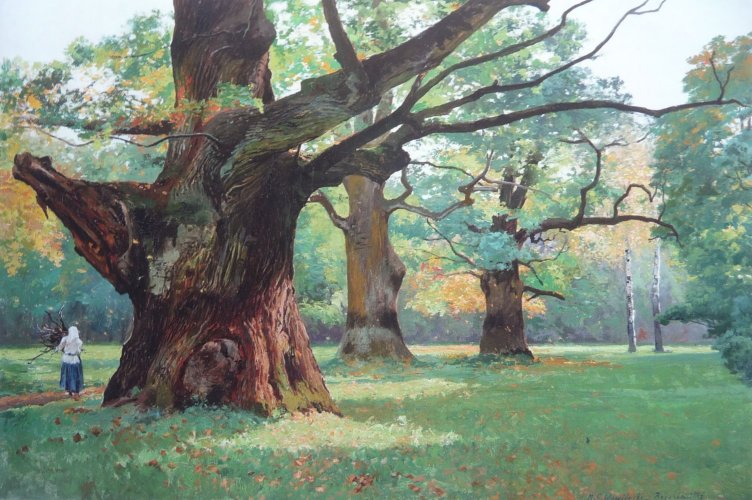Description:
Michał Wywiórski (1861-1926) graduated from the Russian Polytechnic, then studied at the Munich Academy in the workshops of Karl Raupp, Nicolaos Gysis and Joseph Brandt and Alfred Wierusz-Kowalski. Over the years he has exhibited his works both in Poland and abroad. In his work he mainly dealt with landscape painting. He was a member of many painting panorama teams, working with Julian Fałat, Wojciech Kossak or Jan Stanisław. Wywiórski was one of many artists who visited the hospitable Raczyński in Rogalin. While here in 1907 he painted two paintings depicting the famous Rogalin oaks growing in the landscape park and on the Warta river meadows. These are works from the period of active activity of Wywiórski in Poznań, crowned with the establishment in the capital of Greater Poland in 1909 of the Society of Friends of Fine Arts and the Association of Artists in Poznań.
Description of the painting:
In the painting depicting the three oldest oaks of Rogalin, the artist was faithful to the details and sought to capture the play of light breaking through the tangle of branches and illuminating the leaves, which shimmer with a rainbow of autumn colors. This brings the painting, stemming from the premise of realistic painting, closer to Impressionism, which Wywiórski could have encountered during his studies in Munich.
The painting “Old Oaks in Rogalin Park” depicts a view of three seven-hundred-year-old oaks – Lech, Czech and Rus in an early autumn setting. The composition is created according to the diagonal running from the lower left corner, on which the title trees are located. In the foreground is visible the monumental trunk of an oak named Rus. Its spreading branches reach the right edge of the picture plane. The detailed texture of the bark emphasizes the age of the mighty tree. Along the oaks runs a path, on which the artist placed a woman carrying a bundle of wood. Her figure contrasts with the power of the oak. The image is composed of successive plans, on which individual, already less distinct historic oaks are shown: Czech and Lech, and two birches bathed in sunlight at the right edge of the picture, whose presence gives the landscape depth.
The artist on the canvas emphasizes light phenomena. The space around the oaks is shaded showing the immense surface of their crowns, the spaces beyond their reach are bathed in light. Single rays of sunlight penetrate through their leaves creating bright spots on the lawn.
The landscape gives an impression of a sunny, bucolic, peaceful scenery. Through juxtaposing the figure of the woman with the monumental, old oak, the artist shows the timelessness and power of nature’s forces. The rural woman carrying firewood has a symbolic meaning of man’s dependence on nature.


